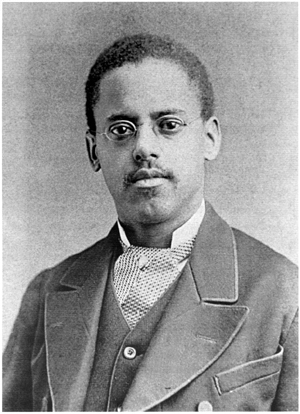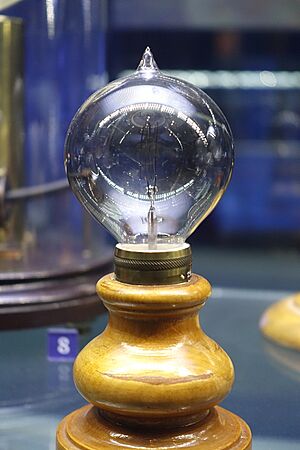Lewis Howard Latimer facts for kids
Quick facts for kids
Lewis Howard Latimer
|
|
|---|---|

Latimer in 1882
|
|
| Born | September 4, 1848 Chelsea, Massachusetts, U.S.
|
| Died | December 11, 1928 (aged 80) |
| Occupation | Inventor, patent consultant, author, engineer, draftsman, Navy Landsman (Rank) |
| Spouse(s) |
Mary Wilson Lewis Latimer
(m. 1873) |
| Children | 2 |
| Parent(s) | George Latimer (1818–1897) Rebecca Latimer (1823–1910) |
Lewis Howard Latimer (born September 4, 1848 – died December 11, 1928) was an amazing American inventor and expert in drawing patents. He created many useful things, like an early version of an air conditioner. He also made a much better way to create carbon filaments for light bulbs, which helped make light bulbs last longer. Latimer also improved the toilet system for railroad cars.
In 1884, he joined the famous Edison Electric Light Company. There, he worked as a draftsman, drawing detailed plans for inventions. His former home, the Lewis H. Latimer House, is now a museum in Flushing, New York City.
Contents
Lewis Latimer's Early Life
Lewis Howard Latimer was born in Chelsea, Massachusetts, on September 4, 1848. He was the youngest of four children born to Rebecca and George Latimer. Before Lewis was born, his parents had bravely escaped from slavery in Virginia. They fled to Chelsea in 1842.
Soon after they arrived, George was recognized and arrested. His trial became very famous. Important people like Frederick Douglass and William Lloyd Garrison helped him. George was eventually able to buy his freedom and live with his family.
When Lewis was young, he helped his father in his barbershop. He also helped his father hang wallpaper at night.
When Lewis was 10, his family faced a difficult time. A court ruling, called the Dred Scott Case, made it harder for formerly enslaved people to prove they were free. Lewis's father, George, had no official proof of his freedom. To protect his family, he likely had to leave.
After his father left, Lewis's mother had to split up the family. Lewis and his brothers were sent to a farm school. His sisters went to stay with a family friend.
Lewis Howard Latimer joined the U.S. Navy when he was 16 years old, on September 16, 1864. He served as a Landsman on the ship USS Massasoit. After leaving the Navy with an honorable discharge in July 1865, he found a job.
He started as an office boy at a patent law firm called Crosby Halstead and Gould. He earned $3.00 a week. There, he learned how to use drafting tools like a set square and ruler. His boss soon noticed Lewis's amazing talent for drawing patent designs. Latimer was promoted to head draftsman by 1872, earning $20 a week.
Lewis H. Latimer married Mary Wilson Lewis on November 15, 1873. They were married in Fall River, Massachusetts. Mary was from Providence, Rhode Island. The couple had two daughters, Emma Jeanette and Louise Rebecca.
In 1879, Latimer, his wife Mary, his mother Rebecca, and his brother William moved to Bridgeport, Connecticut. They settled in a neighborhood called "Little Liberia." This community was started in the early 1800s by free blacks. Other family members already lived there. Mary died in Bridgeport in 1924.
Lewis Latimer's Inventions and Work
Early Inventions
In 1874, Latimer worked with Charles M. Brown to create an improved toilet system for trains. They called it the Water Closet for Railroad Cars.
In 1876, Alexander Graham Bell hired Latimer. Latimer was working at Bell's patent law firm at the time. Bell needed Latimer to draw the detailed plans for his telephone invention. These drawings were needed to get the patent.
In 1879, Latimer moved to Bridgeport, Connecticut. He was hired by the US Electric Lighting Co.. This company was owned by Hiram Maxim, who was a competitor of Thomas Edison. While working there, Latimer invented a new way to make carbon filaments. This new method helped stop the filaments from breaking during the carbonization process. He put the filament blanks inside a cardboard envelope during this process.
Latimer even traveled to England for the Maxim light company. In just nine months, he taught everyone there how to make Maxim lights. This included teaching them how to blow glass, which helped get the factory running.
Working with Thomas Edison
In 1884, Thomas Edison invited Latimer to work with him. Besides his work with Edison, Latimer also translated information into German and French. He also helped gather important technical information.
Latimer also developed an early version of the air conditioner. He called it "Apparatus for cooling and disinfecting."
In 1894, Latimer worked on a patent for a safety elevator. This elevator was designed to prevent people from falling out and into the elevator shaft.
After a company called the Board of Patent Control closed in 1924, Latimer worked with Hammer and Schwartz until he retired.
The Light Bulb
Lewis Latimer made important improvements to the light bulb. On September 13, 1881, he received a patent with Joseph V. Nichols. This patent was for a way to attach carbon filaments to the wires inside an electric lamp.
Then, on January 17, 1882, he received another patent for a "process of manufacturing carbons." This was a method for making carbon filaments for light bulbs. It greatly reduced how often the filaments broke during production. He did this by wrapping the filaments in a cardboard envelope.
The Edison Electric Light Company in New York City hired Latimer in 1884. He worked as a draftsman and an expert witness in legal cases about electric lights. While at Edison, Latimer wrote the first book about electric lighting. It was called Incandescent Electric Lighting (1890). He also helped set up public electric lights in cities like New York, Philadelphia, Montreal, and London.
In 1892, the Edison Electric Light Company joined with another company to form General Electric. Latimer continued to work in the legal department of the new company.
In 1911, he became a patent consultant for law firms. This meant he gave expert advice on patents.
Edison Pioneers
On February 11, 1918, Latimer joined the Edison Pioneers. This was a special group of 100 people who had worked closely with Thomas Edison. Lewis Latimer was the first person of color to join this important group.
Lewis Latimer's Patents
- "Improvement in water-closets for railroad-cars" (with Charles W. Brown), patented February 10, 1874
- "Electric lamp" (with Joseph V. Nichols), patented September 13, 1881
- "Process of Manufacturing Carbons", patented January 17, 1882
- "Supporter for electric lamps" (with John Tregoning), patented March 21, 1882
- "Apparatus for cooling and disinfecting", patented January 12, 1886
- "Locking rack for hats, coats, and umbrellas", patented March 24, 1896
- "Book Supporter", patented February 7, 1905
- "Lamp fixture" (with William Sheil Norton), patented August 30, 1910
Writing and Other Activities
Lewis Latimer was also a talented writer and artist.
- He wrote a book of poetry called Poems of Love and Life.
- He wrote a technical book, Incandescent Electric Lighting (1890).
- He wrote various articles for African-American journals.
- He signed a petition to Mayor Seth Low to help restore a member to the Brooklyn School Board.
Teaching
Latimer enjoyed teaching others. He taught English and drafting courses to immigrants. He taught these classes at the Henry Street Settlement in New York.
Other Talents and Interests
Lewis Latimer had many hobbies. He played the violin and flute. He also painted portraits and wrote plays.
He was an early supporter of civil rights. In 1895, Lewis wrote a statement for the National Conference of Colored Men. This statement was about the importance of equality, security, and opportunity for all people.
In his later years, Latimer remained very patriotic. He was an early and active member of a veteran organization called the Grand Army of the Republic. He served as secretary and adjutant for the group.
Lewis Latimer's Legacy
From 1903 until his death in 1928, Latimer lived with his family in a home in East Flushing, New York. Lewis Latimer passed away on December 11, 1928, at the age of 80.
About 60 years after he died, his home was moved to a new location in Flushing. It was turned into the Lewis H. Latimer House Museum. This museum honors the inventor and his contributions.
- Latimer is a member of the National Inventors Hall of Fame. He was recognized for his work on electric filament manufacturing techniques.
- The Latimer family house is now a museum in Flushing, Queens.
- Latimer was a founding member of the Flushing, New York, Unitarian Church.
- A group of apartment buildings in Flushing are named "Latimer Gardens" after him.
- P.S. 56 in Clinton Hill, Brooklyn, is named Lewis H. Latimer School.
- An invention program at the Massachusetts Institute of Technology, MIT, is named after him.
- On May 10, 1968, a school in Brooklyn, New York, was renamed The Lewis H. Latimer School in his memory.
- In 1988, a committee was formed to save his home in Flushing, New York.
- On September 23, 2023, a gravestone was dedicated to him at his grave in Fall River, Massachusetts.


